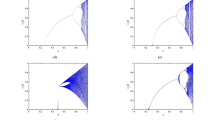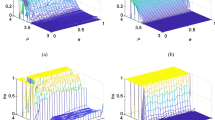Abstract
In this paper, a new image encryption algorithm based on the two-dimensional spatiotemporal chaotic system is proposed.This system mixes linear neighborhood coupling and the nonlinear chaotic map coupling of lattices, and it has more cryptographic features in dynamics than the system of coupled map lattices does. The two-dimensional coupled map lattices (2DCML) system is only a special case in this chaotic system. In addition, bit-level permutation is employed to strengthen security of the cryptosystem. Simulations have been carried out, and the results demonstrate that the proposed algorithm has properties of large key space, high sensitivity to key, strong resisting attack. So, it is more secure and effective algorithm for encryption of digital images.













Similar content being viewed by others
References
Khan M, Shah T (2015) An efficient chaotic image encryption scheme. Neural Comput Appl 26(5):1137–1148
Liu H, Kadir A, Sun X (2017) Chaos-based fast color image encryption scheme with true random number keys from environmental noise. IET Image Process 11(5):324–332
Bagheri P, Shahrokhi M (2016) Neural network-based synchronization of uncertain chaotic systems with unknown states. Neural Comput Appl 27:945–952
Li C, Lin D, Lü J, Hao F (2017) Cryptanalyzing an image encryption algorithm based on autoblocking and electrocardiography. IEEE Multimedia arXiv:1711.01858v2
Belazi A, El-Latif A, Diaconu A, Rhouma R, Belghith S (2017) Chaos-based partial image encryption scheme based on linear fractional and lifting wavelet transforms. Opt Lasers Eng 88:37–50
Nosrati Komeil, Volos Christos, Azemi Asad (2017) Cubature Kalman filter-based chaotic synchronization and image encryption. Signal Process-Image 58:35–48
Liu H, Kadir A, Sun X, Li YL (2018) Chaos based adaptive double-image encryption scheme using hash function and S-boxed. Multimed Tools Appl 77(1):1391–1407
Khan M, Shah T, Batool SI (2016) Construction of S-box based on chaotic Boolean functions and its application in image encryption. Neural Comput Appl 27(3):677–685
Xu L, Gou X, Li Zh, Li J (2017) A novel chaotic image encryption algorithm using block scrambling and dynamic index based diffusion. Opt Lasers Eng 91:41–52
Coulibaly S, Clerc MG, Selmi F, Barbay S (2017) Extreme events following bifurcation to spatiotemporal chaos in a spatially extended microcavity laser. Phys Rev A 95(2):023816
Liu H, Kadir A (2015) Asymmetric color image encryption scheme using 2D discrete-time map. Signal Process 113:104–112
Kanso A, Ghebleh M (2015) A structure-based chaotic hashing scheme. Nonlinear Dyn 81(1–2):27–40
Seyedzadeh SM, Norouzi B, Mosavi MR (2015) A novel color image encryption algorithm based on spatial permutation and quantum chaotic map. Nonlinear Dyn 81(1–2):511–529
Wang XY, Zhang HL, Bao XM (2016) Color image encryption scheme using CML and DNA sequence operations. Biosystems 144:18–26
Sinha S (2002) Random coupling of chaotic maps leads to spatiotemporal synchronization. Phys Rev E 66:016209
Mondal A, Sinha S, Kurths J (2008) Rapidly switched random links enhance spatiotemporal regularity. Phys Rev E 78:066209
Kohar V, Ji P, Choudhary A, Sinha S, Kurths J (2014) Synchronization in time-varying networks. Phys Rev E 90(2):022812
Nag M, Poria S (2016) Synchronization in a network of delay coupled maps with stochastically switching topologies. Chaos Soliton Fract 91(33):9–16
Zhang YQ, Wang XY (2014) Spatiotemporal chaos in mixed linear-nonlinear coupled logistic map lattice. Phys A 402(10):104–118
Zhang YQ, Wang XY (2013) Spatiotemporal chaos in Arnold coupled logistic map lattice. Nonlinear Anal-Model 18(4):526–541
Ercan S, Cahit C (2011) Algebraic break of image ciphers based on discretized chaotic map lattices. Inf Sci 181:227–233
Machkour M, Saaidi A, Benmaati ML (2015) A novel image encryption algorithm based on the two-dimensional logistic map and the Latin square image cipher. 3D Res 6(4):36–54
Fridrich J (1998) Symmetric ciphers based on two-dimensional chaotic maps. Int J Bifurcat Chaos 8:1259
Xie EY, Li C, Yu S (2016) On the cryptanalysis of Fridrich’s chaotic image encryption scheme. Signal Process 132:150–154
Zhang YQ, Wang XY (2015) A new image encryption algorithm based on non-adjacent coupled map lattices. Appl Soft Comput 26:10–20
Kaneko K (1989) Spatiotemporal chaos in one- and two-dimensional coupled map lattices. Physica D 37:60–82
Kaneko K (1993) Theory and application of coupled map lattices, Chapter 1. Wiley
Zhang W, Wong KW, Yu H, Zhu ZL (2013) A symmetric color image encryption algorithm using the intrinsic features of bit distributions. Commun Nonlinear Sci Numer Simul 18:584–600
Zhu ZL, Zhang W, Wong KW, Yu H (2011) A chaos-based symmetric image encryption scheme using a bit-level permutation. Inf Sci 181:1171–1186
Li C (2016) Cracking a hierarchical chaotic image encryption algorithm based on permutation. Signal Process 118:203–210
Kar M, Mandal MK, Nandi D (2016) Bit-plane encrypted image cryptosystem using chaotic, quadratic, and cubic maps. Iete Tech Rev 33(6):651–661
Praveenkumar P, Amirtharajan R, Thenmozhi K, Rayappan JBB (2017) Fusion of confusion and diffusion: a novel image encryption approach. Telecommun Syst 65(1):65–78
Li C, Lo KT (2011) Optimal quantitative cryptanalysis of permutation-only multimedia ciphers against plaintext attacks. Signal Process 91(4):949–954
Shibata H (2001) KS entropy and mean Lyapunov exponent for coupled map lattices. Phys A 292:182–192
Zhang YQ, Wang XY (2014) A symmetric image encryption algorithm based on mixed linear-nonlinear coupled map lattice. Inf Sci 273(8):329–351
Li C, Lin D, Lü J (2017) Cryptanalyzing an image-scrambling encryption algorithm of pixel bits. IEEE Multimedia 24(3):64–71
Chai XL, Gan ZH, Yuan K (2017) An image encryption scheme based on three-dimensional Brownian motion and chaotic system. Chinese Phys B 26(2):020504
Zahmoul R, Ejbali R, Zaied M (2017) Image encryption based on new Beta chaotic maps. Opt Lasers Eng 96:39–49
Lian S, Sun J, Wang Z (2005) A block cipher based on a suitable use of the chaotic standard map. Chaos Soliton Fract 26(1):117–129
Özkaynak F (2018) Brief review on application of nonlinear dynamics in image encryption. Nonlinear Dyn 92(2):305–313
Acknowledgements
This research is supported by the Program for New Century Excellent Talents in Fujian Province University, Zhangzhou Science and Technology Project (No.ZZ2018J23), the Natural Science Foundation of Fujian Province of China (No.2018J01100), National Natural Science Foundation of China (Nos: 61672124, 61173183, and 61370145), Program for Liaoning Excellent Talents in University (No:LR2012003), the Password Theory Project of the 13th Five-Year Plan National Cryptography Development Fund (No: MMJJ20170203).
Author information
Authors and Affiliations
Corresponding author
Ethics declarations
Conflict of interest
We declare that we have no financial and personal relationships with other people or organizations that can inappropriately influence our work, and there is no professional or other personal interest of any nature or kind in any product, service and/or company that could be construed as influencing the position presented in, or the review of, this manuscript.
Rights and permissions
About this article
Cite this article
He, Y., Zhang, YQ. & Wang, XY. A new image encryption algorithm based on two-dimensional spatiotemporal chaotic system. Neural Comput & Applic 32, 247–260 (2020). https://doi.org/10.1007/s00521-018-3577-z
Received:
Accepted:
Published:
Issue Date:
DOI: https://doi.org/10.1007/s00521-018-3577-z




